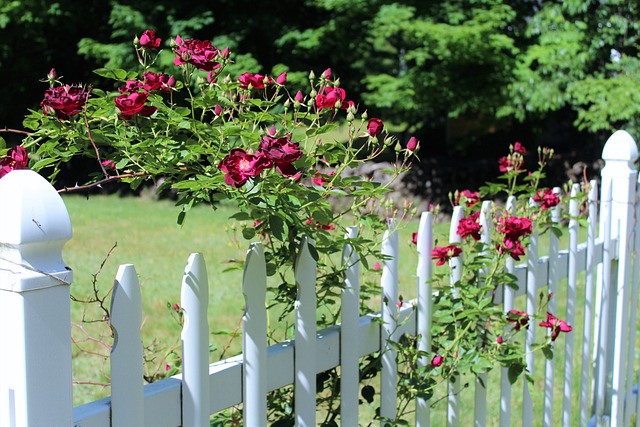Fencing is not just about defining your outdoor space; it’s an investment that requires thoughtful maintenance. This guide delves into the art of fence staining and sealing, crucial steps to protect and enhance your wooden fences. From understanding the benefits of staining to choosing the perfect color and formula, preparing your fence, and applying the sealant properly, we’ll walk you through each stage. Learn how regular maintenance and touch-ups ensure your fence remains a stunning and durable feature for years to come.
- Understanding Fence Staining: Benefits and Types
- Preparing Your Wooden Fence for Staining
- Choosing the Right Stain: Color and Formula
- Sealing for Protection: Application and Tips
- Maintenance and Touch-Ups: Ensuring Longevity
Understanding Fence Staining: Benefits and Types
Fence staining is a popular method to enhance the appearance and protect wooden fences. It involves applying a pigmented sealer or paint to the fence’s surface, offering various benefits. Firstly, it provides an attractive finish, allowing homeowners to choose from a wide range of colors to match their landscape design or personal style. Staining also protects wood from the elements, including UV rays, rain, and snow, which can cause fading and rot over time.
There are two primary types of fence staining: semi-transparent and solid. Semi-transparent stains allow some light to pass through, preserving the wood’s natural look while providing a subtle color. Solid stains, on the other hand, create a more dramatic effect by blocking light and offering rich, vibrant colors. Each type has its advantages, catering to different preferences and protection needs.
Preparing Your Wooden Fence for Staining
Preparing your wooden fence for staining is a crucial step to ensure optimal results and extend the life of your fence. Start by cleaning the fence thoroughly to remove any dirt, debris, or mildew buildup. Use a pressure washer or a garden hose with a spray nozzle to blast away surface grime. This initial cleaning will help the stain adhere better and create a smooth canvas for application.
Once cleaned, inspect the fence for any damaged or rotten sections. Repair or replace these areas to prevent further deterioration. Sanding the fence gently can also help smooth out rough surfaces and ensure an even coat of stain. Make sure the wood is dry before proceeding to the staining stage, as moisture can negatively affect the staining process and the longevity of the finish.
Choosing the Right Stain: Color and Formula
Choosing the right stain for your wooden fence is a crucial step in ensuring both aesthetic appeal and longevity of the finish. Start by evaluating the color options, considering the ambiance you want to create in your outdoor space. Dark stains offer rich, dramatic effects, while lighter shades can provide a more subtle, natural look. The formula of the stain is equally important; water-based stains are generally easier to apply and have less offensive odors compared to oil-based ones. Water-based formulas also tend to dry faster and create a more uniform finish.
When selecting a color, take into account the existing shade of your wood and how much sunlight it receives. Lighter woods may require lighter stains to prevent them from looking washed out, while darker woods can handle deeper hues that will enhance their natural beauty. Always test a small area first to ensure the stain reacts well with the wood and achieves the desired effect.
Sealing for Protection: Application and Tips
Sealing a wooden fence is an essential step to protect it from the elements, enhance its durability, and preserve its beauty. The primary purpose of sealing is to create a barrier between the wood and potential damage causes like water, UV rays, and mold growth. Choose a high-quality sealant designed specifically for exterior use on wood. When applying the sealant, ensure you follow the manufacturer’s instructions carefully. Typically, this involves cleaning the fence first to remove any dirt or debris, then applying an even coat of sealant with a brush or roller, allowing it to dry before adding additional layers for maximum protection.
Remember that different sealants offer varying levels of protection and aesthetics. Some provide a natural look, while others add a subtle color boost to enhance the wood grain. For areas prone to harsh weather conditions, opt for water-repellent sealants with high UV resistance ratings. Regular sealing every one or two years will ensure your wooden fence remains in excellent condition for many years to come.
Maintenance and Touch-Ups: Ensuring Longevity
Regular maintenance and touch-ups are essential to keep your wooden fence looking its best and prolong its lifespan. Over time, exposure to elements like sunlight, rain, and harsh winds can cause fading, peeling, or cracking of the stain. A biannual inspection is recommended to identify any damaged areas.
During these checks, clean the fence surface to remove dirt and mildew growth before applying a fresh coat of stain or sealant. Touch-up specific problem spots with a small brush or roller, matching the existing color as closely as possible. Regular maintenance not only restores the aesthetic appeal but also protects the wood by preventing further deterioration.
